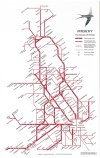I recall using Huntingdon station having some limited intercity services and I used them regularly in around 1994/95. My question is not so much why do they not bring them back but why Huntingdon had them in the first place?
There is a lot of confusion here.
Significant numbers of long distance trains calling at Huntingdon was a diesel era thing.
In the days of steam the service to intermediate stations between Hitchin and Peterborough was part of the ECML service not the suburban service. Huntingdon, St Neots, Sandy and Biggleswade were little market towns with a sparse service of loco hauled trains to/from Kings Cross, and usually referred to as parliamentary services, or parlies. Arlesey had closed in 1959. The trains were mostly steam hauled right up to the closure of Top Shed in 1963.
Was the fact Huntingdon used to be an old junction station for lines to Cambridge and Kettering possibly a factor as well? The lines may have been long gone, but the historic calling patterns may have persisted much longer?
No, St Ives-Kettering closed in 1959, and had its own station Huntingdon East, though it was almost adjacent to Huntingdon North. The Kettering-Cambridge service was 3 trains per day.
Things began to change in the 1960s. St Neots had the Longsands and Cromwell Road estates, Huntingdon had Oxmoor. Various services had gone over to DMU when steam finished but it was only in 1967 that this became a 1tp2h service Hitchin-Huntingdon, with ECML Inter City sweeper services calling at Huntingdon to provide connections for Peterborough. There were sill a few loco hauled through trains Peterborough to/from Kings Cross, mostly at peak times, and still referred to as the Peterborough parlies.
Huntingdon used to have IC calls before Stevenage was rebuilt, then Stevenage tended to get them in preference.
The new station at Stevenage opened in 1973. The Inter City calls there replaced calls at Hitchin, not Huntingdon.
I believe Huntingdon was rebuilt removing the island platform?
There were various other ECML upgrades in the 1970s. Bottlenecks at Arlesey, Sandy and Huntingdon were removed, and a big realignment at Offord to increase speeds. It was as a result of putting 4 tracks through Sandy and Huntingdon that they lost their platforms on the fast lines. New fast/slow line crossovers were installed but these were 40 mph. It all happened a bit too early to get 70 mph turnouts.
Weren't a number of the Class 101 shuttles from Hitchin only operated to Huntingdon, because that was the limit of the NSE area (realistically) pre-electrification?
The next big event was the introduction of electric trains to Royston in 1978. The Hitchin-Huntingdon shuttle increased to hourly, connecting with the fast Royston trains, and got refurbished Met Cam DMUS, which were based at Cambridge and also worked the Royston shuttle. There was sufficient gaps in the ECML service for the DMUs to shunt across from the down side to the up bay, and the driver didn't have to walk far to get from one end of the train to the other!
It was in this era that the HSTs arrived and the Deltics spent their final years on the Kings Cross-York sweeper services. There were three Deltics that I only travelled behind once, all of them are Kings Cross-Huntingdon or vice versa.
There were a number of Peterborough starters formed of HSTs in the 80s prior to the wires making it to Peterborough in around 1987/8. These were formed of HSTs running empty from Bounds Green that were to form the mid morning departures from KX before the first up trains from further afield made it south. Useful extra runs in otherwise dead time for the stock, a d helped developed the Peterborough / Huntingdon commuter market for when electrification was completed.
Electrification brought the Hitchin-Peterborough service firmly into the NSE orbit. The Peterborough patly loco hauled trains mostly finished in May 1987. One morning HST working lasted for a little while after electrification, and ended in May 1990. But, generally speaking, Inter City would have been delighted at not needing to call at Huntingdon any more
The local MP was the PM at the time!
All of this happened before John Major became Prime Minister.
It seems to me that Peterborough makes an obvious location to change trains if heading further north and Huntingdon and St Neots have a decent half hourly service into central London and beyond into the South at Gatwick/Horsham.
It is important to note that the Huntingdon-Peterborough one way flow is big, at 117k. Peterborough is Huntingdon's most important station after St Pancras, and Huntingdon is Peterborough's most important station after Kings Cross. Nice as it might be to terminate Thameslink at Huntingdon (or Alconbury?) the big difficulty is that it isn't feasible to pile all of those Huntingdon-Peterborough journeys onto long distance trains.

